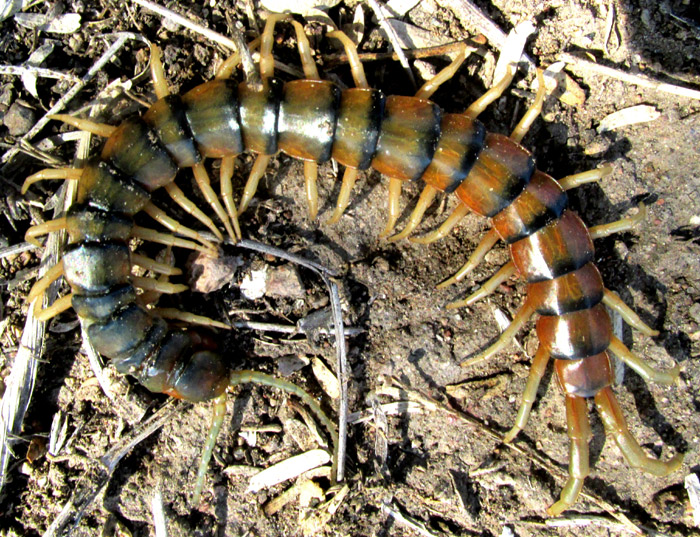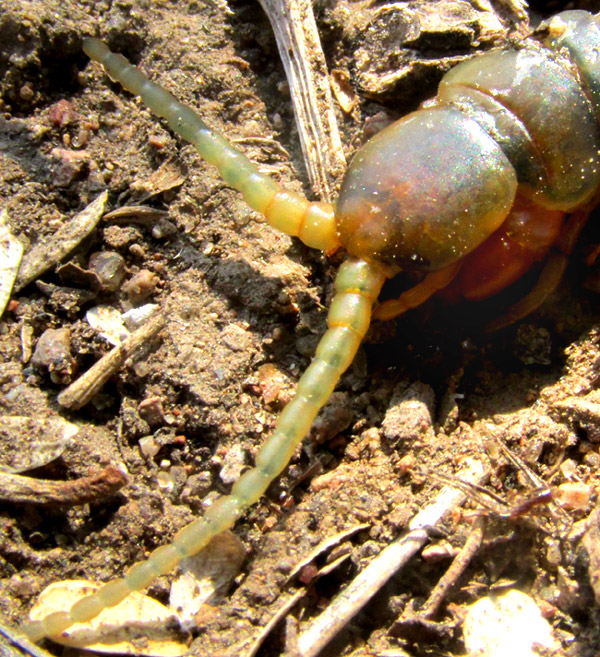Excerpts from Jim Conrad's
Naturalist Newsletter
Entry dated July 26, 2023, issued from near Tequisquiapan, elevation about 1,900m (6200 ft), Querétaro state, MÉXICO
(~N20.57°, ~W99.89°)
BARK CENTIPEDE

The above large centipede was alive but unmoving in a dry scrub zone mostly vegetated with mesquites and grass. Tiny black ants moved around and beneath it, so I supposed it was sick or injured, and the ants were ready to hollow it out.

In the top, right corner of the above picture it looks like an injury, maybe where a bird had pecked it. The image shows the centipede's head and antennae. The short, slender, segmented item immediately below the head, looking like a diminutive antenna, is one of two second maxillae -- the first pair being hidden under the head. Maxillae are mouthparts, so the first and second pairs of maxillae work together to feel and manipulate food. The much thicker item arising from between the head and the first body segment is one of two highly modified legs known as forcipules. Forcipules, like forceps, are pincer-like. They curve inward beneath the centipede's head, where they can clamp down on prey. Venom is produced by glands inside the head, then passes through a tube inside each forciple, to the sharp points, where it's injected into the prey.

As with many other centipedes, the rear end terminates with another pair of highly modified legs, as seen above looking less like legs than a set of smaller antennae. They're called ultimate or terminal legs, and their use varies from species to species, though they're not used for walking. Normally they're more sensitive to touch than the other legs, so can serve as a rear set of antennae, which come in handy if the centipede wants to back up. In some species the terminal legs also help to capture prey and/or take part in mating.
To identify our centipede, pictures on the Internet were searched for using the keywords "centipede Mexico" except that in my case I used the Spanish word for centipede, which is ciempiés, just meaning hundred-legger. Among the many resulting thumbnails -- paying special attention not only to the unusual color of ours but also the antennae and terminal legs -- some appeared to match our individual. They belonged to the genus Hemiscolopendra, whose species are known as bark centipedes.
Then, on the GBIF Hemiscolopendra page, I saw that species of that genus occur in the Eastern US and Mexico, as well as southern South America. On the map, zooming in on our part of central Mexico and then clicking on "explore," only one species was reported as observed in our area, and that was HEMISCOLOPENDRA MARGINATA. Internet pictures labeled with that name looked like our species.
However, several images labeled Scolopendra viridis also looked like our species, and that species also is found in our region, possibly even more commonly than our Hemiscolopendra marginata. At least in the images I've seen, one difference between the two species is that on the terminal legs of our Hemiscolopendra marginata, the segment next to the body is shorter and thicker than that segment on Scolopendra viridis. These species' similarity is discussed at BugGuide.Com, where Jeff Hollenbeck in Florida says that the two species, though so hard to distinguish, display very different habits. Scolopendra viridis is "lightning fast and flies out of view the moment it's uncovered," while our Hemiscolopendra marginata is sluggish and either sits still when uncovered or moves away slowly.
Our Hemiscolopendra marginata is fairly common in the eastern US into eastern Mexico, south to about Oaxaca. In the US often it's referred to as the Eastern Bark Centipede, but in Mexico it's more "central" than "eastern" so we'll just call it bark centipede.
Bark centipedes in general are described as hiding beneath flakes of bark on trees. However, the only trees where our centipede occurred were Smooth Mesquites, whose bark is hard and solid, not flaking. Here the species must find other shelter, such as beneath fallen pricklypear cactus pads. In Kentucky they're said to reach up to 75mm (3 inches), which is about right for our individual. BugGuide.Net mentions that a good field mark is that the legs display blue spots, in pictures seen to occur on outer leg segments, at the base of each segment. Our individual shows no blue on the legs at all.